Wenbo Li
SODiff: Semantic-Oriented Diffusion Model for JPEG Compression Artifacts Removal
Aug 10, 2025Abstract:JPEG, as a widely used image compression standard, often introduces severe visual artifacts when achieving high compression ratios. Although existing deep learning-based restoration methods have made considerable progress, they often struggle to recover complex texture details, resulting in over-smoothed outputs. To overcome these limitations, we propose SODiff, a novel and efficient semantic-oriented one-step diffusion model for JPEG artifacts removal. Our core idea is that effective restoration hinges on providing semantic-oriented guidance to the pre-trained diffusion model, thereby fully leveraging its powerful generative prior. To this end, SODiff incorporates a semantic-aligned image prompt extractor (SAIPE). SAIPE extracts rich features from low-quality (LQ) images and projects them into an embedding space semantically aligned with that of the text encoder. Simultaneously, it preserves crucial information for faithful reconstruction. Furthermore, we propose a quality factor-aware time predictor that implicitly learns the compression quality factor (QF) of the LQ image and adaptively selects the optimal denoising start timestep for the diffusion process. Extensive experimental results show that our SODiff outperforms recent leading methods in both visual quality and quantitative metrics. Code is available at: https://github.com/frakenation/SODiff
CleanUpBench: Embodied Sweeping and Grasping Benchmark
Aug 07, 2025Abstract:Embodied AI benchmarks have advanced navigation, manipulation, and reasoning, but most target complex humanoid agents or large-scale simulations that are far from real-world deployment. In contrast, mobile cleaning robots with dual mode capabilities, such as sweeping and grasping, are rapidly emerging as realistic and commercially viable platforms. However, no benchmark currently exists that systematically evaluates these agents in structured, multi-target cleaning tasks, revealing a critical gap between academic research and real-world applications. We introduce CleanUpBench, a reproducible and extensible benchmark for evaluating embodied agents in realistic indoor cleaning scenarios. Built on NVIDIA Isaac Sim, CleanUpBench simulates a mobile service robot equipped with a sweeping mechanism and a six-degree-of-freedom robotic arm, enabling interaction with heterogeneous objects. The benchmark includes manually designed environments and one procedurally generated layout to assess generalization, along with a comprehensive evaluation suite covering task completion, spatial efficiency, motion quality, and control performance. To support comparative studies, we provide baseline agents based on heuristic strategies and map-based planning. CleanUpBench bridges the gap between low-level skill evaluation and full-scene testing, offering a scalable testbed for grounded, embodied intelligence in everyday settings.
QuantVSR: Low-Bit Post-Training Quantization for Real-World Video Super-Resolution
Aug 06, 2025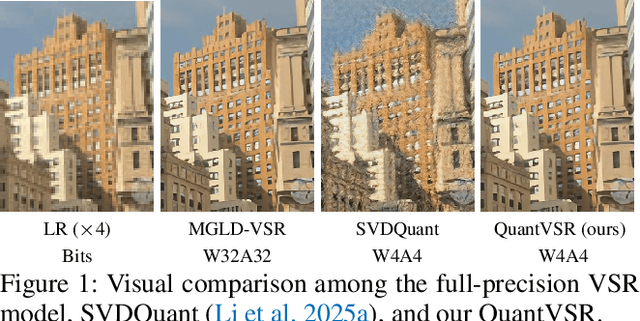

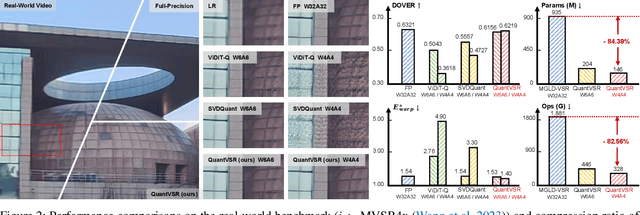

Abstract:Diffusion models have shown superior performance in real-world video super-resolution (VSR). However, the slow processing speeds and heavy resource consumption of diffusion models hinder their practical application and deployment. Quantization offers a potential solution for compressing the VSR model. Nevertheless, quantizing VSR models is challenging due to their temporal characteristics and high fidelity requirements. To address these issues, we propose QuantVSR, a low-bit quantization model for real-world VSR. We propose a spatio-temporal complexity aware (STCA) mechanism, where we first utilize the calibration dataset to measure both spatial and temporal complexities for each layer. Based on these statistics, we allocate layer-specific ranks to the low-rank full-precision (FP) auxiliary branch. Subsequently, we jointly refine the FP and low-bit branches to achieve simultaneous optimization. In addition, we propose a learnable bias alignment (LBA) module to reduce the biased quantization errors. Extensive experiments on synthetic and real-world datasets demonstrate that our method obtains comparable performance with the FP model and significantly outperforms recent leading low-bit quantization methods. Code is available at: https://github.com/bowenchai/QuantVSR.
LoViC: Efficient Long Video Generation with Context Compression
Jul 17, 2025Abstract:Despite recent advances in diffusion transformers (DiTs) for text-to-video generation, scaling to long-duration content remains challenging due to the quadratic complexity of self-attention. While prior efforts -- such as sparse attention and temporally autoregressive models -- offer partial relief, they often compromise temporal coherence or scalability. We introduce LoViC, a DiT-based framework trained on million-scale open-domain videos, designed to produce long, coherent videos through a segment-wise generation process. At the core of our approach is FlexFormer, an expressive autoencoder that jointly compresses video and text into unified latent representations. It supports variable-length inputs with linearly adjustable compression rates, enabled by a single query token design based on the Q-Former architecture. Additionally, by encoding temporal context through position-aware mechanisms, our model seamlessly supports prediction, retradiction, interpolation, and multi-shot generation within a unified paradigm. Extensive experiments across diverse tasks validate the effectiveness and versatility of our approach.
T-Rex: Task-Adaptive Spatial Representation Extraction for Robotic Manipulation with Vision-Language Models
Jun 24, 2025Abstract:Building a general robotic manipulation system capable of performing a wide variety of tasks in real-world settings is a challenging task. Vision-Language Models (VLMs) have demonstrated remarkable potential in robotic manipulation tasks, primarily due to the extensive world knowledge they gain from large-scale datasets. In this process, Spatial Representations (such as points representing object positions or vectors representing object orientations) act as a bridge between VLMs and real-world scene, effectively grounding the reasoning abilities of VLMs and applying them to specific task scenarios. However, existing VLM-based robotic approaches often adopt a fixed spatial representation extraction scheme for various tasks, resulting in insufficient representational capability or excessive extraction time. In this work, we introduce T-Rex, a Task-Adaptive Framework for Spatial Representation Extraction, which dynamically selects the most appropriate spatial representation extraction scheme for each entity based on specific task requirements. Our key insight is that task complexity determines the types and granularity of spatial representations, and Stronger representational capabilities are typically associated with Higher overall system operation costs. Through comprehensive experiments in real-world robotic environments, we show that our approach delivers significant advantages in spatial understanding, efficiency, and stability without additional training.
AntiGrounding: Lifting Robotic Actions into VLM Representation Space for Decision Making
Jun 14, 2025Abstract:Vision-Language Models (VLMs) encode knowledge and reasoning capabilities for robotic manipulation within high-dimensional representation spaces. However, current approaches often project them into compressed intermediate representations, discarding important task-specific information such as fine-grained spatial or semantic details. To address this, we propose AntiGrounding, a new framework that reverses the instruction grounding process. It lifts candidate actions directly into the VLM representation space, renders trajectories from multiple views, and uses structured visual question answering for instruction-based decision making. This enables zero-shot synthesis of optimal closed-loop robot trajectories for new tasks. We also propose an offline policy refinement module that leverages past experience to enhance long-term performance. Experiments in both simulation and real-world environments show that our method outperforms baselines across diverse robotic manipulation tasks.
FastFLUX: Pruning FLUX with Block-wise Replacement and Sandwich Training
Jun 10, 2025Abstract:Recent advancements in text-to-image (T2I) generation have led to the emergence of highly expressive models such as diffusion transformers (DiTs), exemplified by FLUX. However, their massive parameter sizes lead to slow inference, high memory usage, and poor deployability. Existing acceleration methods (e.g., single-step distillation and attention pruning) often suffer from significant performance degradation and incur substantial training costs. To address these limitations, we propose FastFLUX, an architecture-level pruning framework designed to enhance the inference efficiency of FLUX. At its core is the Block-wise Replacement with Linear Layers (BRLL) method, which replaces structurally complex residual branches in ResBlocks with lightweight linear layers while preserving the original shortcut connections for stability. Furthermore, we introduce Sandwich Training (ST), a localized fine-tuning strategy that leverages LoRA to supervise neighboring blocks, mitigating performance drops caused by structural replacement. Experiments show that our FastFLUX maintains high image quality under both qualitative and quantitative evaluations, while significantly improving inference speed, even with 20\% of the hierarchy pruned. Our code will be available soon.
OPeRA: A Dataset of Observation, Persona, Rationale, and Action for Evaluating LLMs on Human Online Shopping Behavior Simulation
Jun 05, 2025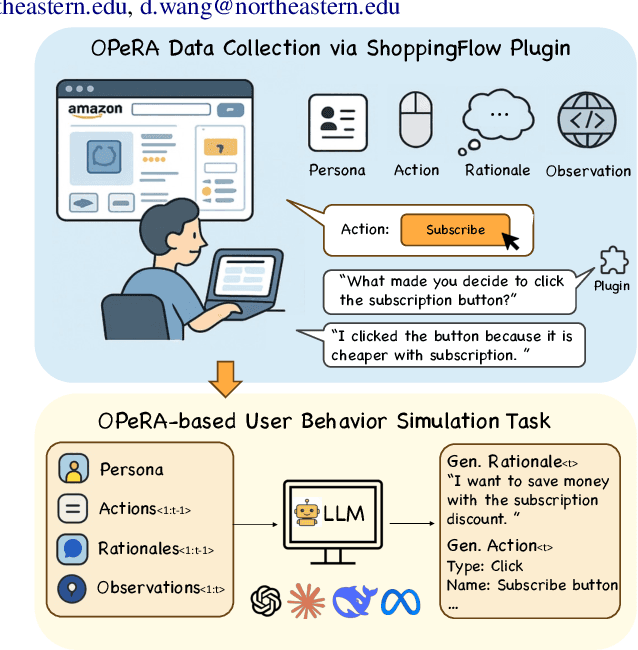
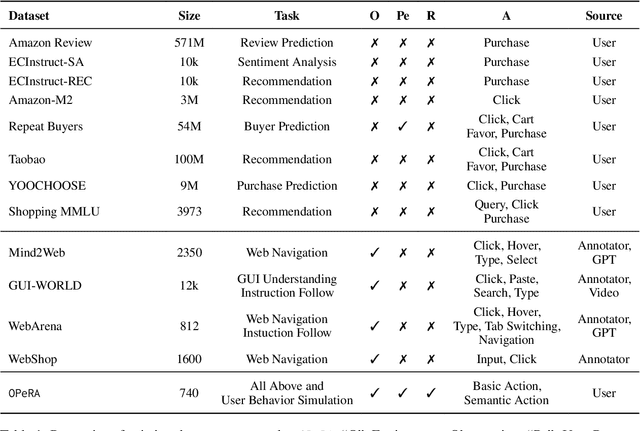
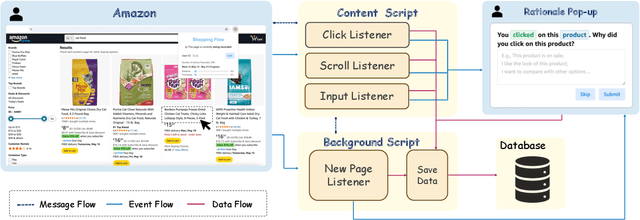
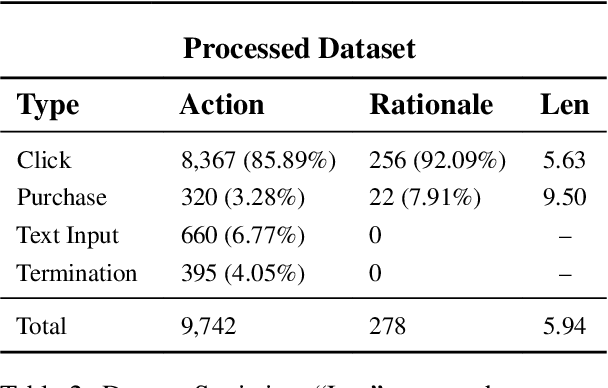
Abstract:Can large language models (LLMs) accurately simulate the next web action of a specific user? While LLMs have shown promising capabilities in generating ``believable'' human behaviors, evaluating their ability to mimic real user behaviors remains an open challenge, largely due to the lack of high-quality, publicly available datasets that capture both the observable actions and the internal reasoning of an actual human user. To address this gap, we introduce OPERA, a novel dataset of Observation, Persona, Rationale, and Action collected from real human participants during online shopping sessions. OPERA is the first public dataset that comprehensively captures: user personas, browser observations, fine-grained web actions, and self-reported just-in-time rationales. We developed both an online questionnaire and a custom browser plugin to gather this dataset with high fidelity. Using OPERA, we establish the first benchmark to evaluate how well current LLMs can predict a specific user's next action and rationale with a given persona and <observation, action, rationale> history. This dataset lays the groundwork for future research into LLM agents that aim to act as personalized digital twins for human.
OSCAR: One-Step Diffusion Codec Across Multiple Bit-rates
May 22, 2025Abstract:Pretrained latent diffusion models have shown strong potential for lossy image compression, owing to their powerful generative priors. Most existing diffusion-based methods reconstruct images by iteratively denoising from random noise, guided by compressed latent representations. While these approaches have achieved high reconstruction quality, their multi-step sampling process incurs substantial computational overhead. Moreover, they typically require training separate models for different compression bit-rates, leading to significant training and storage costs. To address these challenges, we propose a one-step diffusion codec across multiple bit-rates. termed OSCAR. Specifically, our method views compressed latents as noisy variants of the original latents, where the level of distortion depends on the bit-rate. This perspective allows them to be modeled as intermediate states along a diffusion trajectory. By establishing a mapping from the compression bit-rate to a pseudo diffusion timestep, we condition a single generative model to support reconstructions at multiple bit-rates. Meanwhile, we argue that the compressed latents retain rich structural information, thereby making one-step denoising feasible. Thus, OSCAR replaces iterative sampling with a single denoising pass, significantly improving inference efficiency. Extensive experiments demonstrate that OSCAR achieves superior performance in both quantitative and visual quality metrics. The code and models will be released at https://github.com/jp-guo/OSCAR.
PMQ-VE: Progressive Multi-Frame Quantization for Video Enhancement
May 18, 2025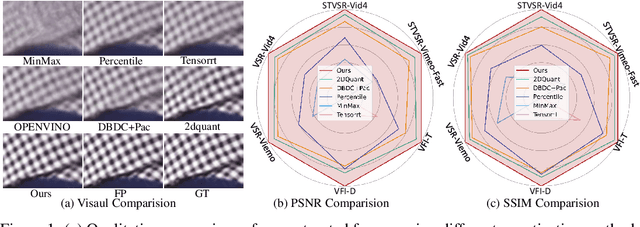
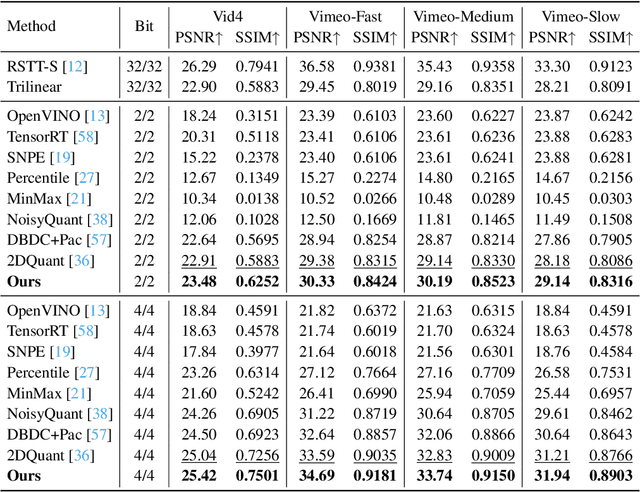

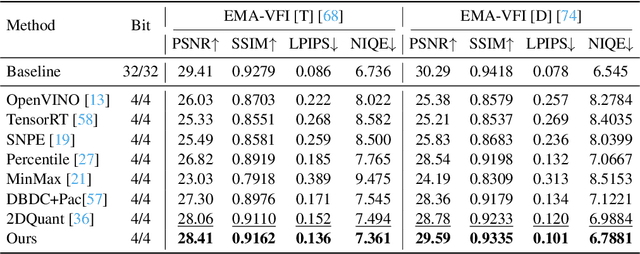
Abstract:Multi-frame video enhancement tasks aim to improve the spatial and temporal resolution and quality of video sequences by leveraging temporal information from multiple frames, which are widely used in streaming video processing, surveillance, and generation. Although numerous Transformer-based enhancement methods have achieved impressive performance, their computational and memory demands hinder deployment on edge devices. Quantization offers a practical solution by reducing the bit-width of weights and activations to improve efficiency. However, directly applying existing quantization methods to video enhancement tasks often leads to significant performance degradation and loss of fine details. This stems from two limitations: (a) inability to allocate varying representational capacity across frames, which results in suboptimal dynamic range adaptation; (b) over-reliance on full-precision teachers, which limits the learning of low-bit student models. To tackle these challenges, we propose a novel quantization method for video enhancement: Progressive Multi-Frame Quantization for Video Enhancement (PMQ-VE). This framework features a coarse-to-fine two-stage process: Backtracking-based Multi-Frame Quantization (BMFQ) and Progressive Multi-Teacher Distillation (PMTD). BMFQ utilizes a percentile-based initialization and iterative search with pruning and backtracking for robust clipping bounds. PMTD employs a progressive distillation strategy with both full-precision and multiple high-bit (INT) teachers to enhance low-bit models' capacity and quality. Extensive experiments demonstrate that our method outperforms existing approaches, achieving state-of-the-art performance across multiple tasks and benchmarks.The code will be made publicly available at: https://github.com/xiaoBIGfeng/PMQ-VE.
 Add to Chrome
Add to Chrome Add to Firefox
Add to Firefox Add to Edge
Add to Edge